Early to Late VSV-G Expression in AcMNPV BV Enhances Transduction in Mammalian Cells but Does Not Affect Virion Yield in Insect Cells
Abstract
1. Introduction
2. Materials and Methods
2.1. Bioinformatics Studies
2.2. Maintenance of Insect and Mammalian Cell Lines
2.3. Generation of Recombinant Plasmids
2.4. Generation of Recombinant Baculoviruses
2.5. Expression Timing Assay of the ie-1, gp64, and p10 Promoters
2.6. VSV-G Immunodetection by Western Blot
2.7. Pseudotyped BV Infection Kinetics in Insect Cells
2.8. Syncytium Formation Assay
2.9. Mammalian Cell Lines Transduction Assay
2.10. Hind Limb Rat Transduction Assay
3. Results and Discussion
3.1. VSV-G and GP64 Comparative Studies
3.2. Recombinant Baculoviruses Expressing VSV-G
3.3. Infectious Capacity in Insect Cells
3.4. Transduction Activity in Mammalian Cells
4. Conclusions
Supplementary Materials
Author Contributions
Funding
Institutional Review Board Statement
Informed Consent Statement
Data Availability Statement
Acknowledgments
Conflicts of Interest
Abbreviations
| AcMNPV | Autographa californica multiple nucleopolyhedrovirus |
| BSA | Bovine Serum Albumin |
| BV | Budded virion |
| DAPI | 4`,6-diamidino-2-phenylindole |
| FBS | Fetal Bovine Serum |
| FFU | Foci-Forming Unit |
| GFP | Green Fluorescent Protein |
| H&E | hematoxylin and eosin |
| hpi | Hours post-infection |
| IVP | Infectious Viral Particle |
| MOI | Multiplicities Of Infection |
| ODV | Occluded Derived Virion |
| PBS | Phosphate-Buffered Saline |
| PEI | Polyethylenimine |
| VSV-G | G-protein of the vesicular stomatitis virus |
References
- Rohrmann, G.F. Baculovirus Molecular Biology, 4th ed.; National Center for Biotechnology Information: Bethesda, MD, USA, 2019. [Google Scholar]
- Cerrudo, C.S.; Motta, L.F.; Cuccovia Warlet, F.U.; Lassalle, F.M.; Simonin, J.A.; Belaich, M.N. Protein-Gene Orthology in Baculoviridae: An Exhaustive Analysis to Redefine the Ancestrally Common Coding Sequences. Viruses 2023, 15, 1091. [Google Scholar] [CrossRef]
- Smith, G.E.; Summers, M.D.; Fraser, M.J. Production of Human Beta Interferon in Insect Cells Infected with a Baculovirus Expression Vector. Mol. Cell. Biol. 1983, 3, 2156–2165. [Google Scholar] [CrossRef]
- Gao, R.; McCormick, C.J.; Arthur, M.J.P.; Ruddell, R.; Oakley, F.; Smart, D.E.; Murphy, F.R.; Harris, M.P.G.; Mann, D.A. High Efficiency Gene Transfer into Cultured Primary Rat and Human Hepatic Stellate Cells Using Baculovirus Vectors. Liver 2002, 22, 15–22. [Google Scholar] [CrossRef] [PubMed]
- Hofmann, C.; Sandig, V.; Jennings, G.; Rudolph, M.; Schlag, P.; Strauss, M. Efficient Gene Transfer into Human Hepatocytes by Baculovirus Vectors. Proc. Natl. Acad. Sci. USA 1995, 92, 10099–10103. [Google Scholar] [CrossRef] [PubMed]
- Hu, Y.C. Baculovirus Vectors for Gene Therapy. Adv. Virus Res. 2006, 68, 287–320. [Google Scholar] [CrossRef] [PubMed]
- Grose, C.; Putman, Z.; Esposito, D. A Review of Alternative Promoters for Optimal Recombinant Protein Expression in Baculovirus-Infected Insect Cells. Protein Expr. Purif. 2021, 186, 105924. [Google Scholar] [CrossRef]
- Hefferon, K.L.; Miller, L.K. Reconstructing the Replication Complex of AcMNPV. Eur. J. Biochem. 2002, 269, 6233–6240. [Google Scholar] [CrossRef]
- Shrestha, A.; Bao, K.; Chen, Y.R.; Chen, W.; Wang, P.; Fei, Z.; Blissard, G.W. Global Analysis of Baculovirus Autographa californica Multiple Nucleopolyhedrovirus Gene Expression in the Midgut of the Lepidopteran Host Trichoplusia ni. J. Virol. 2018, 92, e01277-18. [Google Scholar] [CrossRef]
- Hoopes, R.R., Jr.; Rohrmann, G.F. In Vitro Transcription of Baculovirus Immediate Early Genes: Accurate mRNA Initiation by Nuclear Extracts from Both Insect and Human Cells. Proc. Natl. Acad. Sci. USA 1991, 88, 4513–4517. [Google Scholar] [CrossRef]
- Berretta, M.; Ferrelli, L.; Salvador, R.; Sciocco, A.; Romanowski, V. Baculovirus Gene Expression. In Current Issues in Molecular Virology—Viral Genetics and Biotechnological Applications; InTech: Vienna, Austria, 2013; pp. 57–78. [Google Scholar] [CrossRef]
- Jarvis, D.L.; Fleming, J.A.; Kovacs, G.R.; Summers, M.D.; Guarino, L.A. Use of Early Baculovirus Promoters for Continuous Expression and Efficient Processing of Foreign Gene Products in Stably Transformed Lepidopteran Cells. Biotechnology 1990, 8, 950–955. [Google Scholar] [CrossRef]
- Jarvis, D.L.; Weinkauf, C.; Guarino, L.A. Immediate-Early Baculovirus Vectors for Foreign Gene Expression in Transformed or Infected Insect Cells. Protein Expr. Purif. 1996, 8, 191–203. [Google Scholar] [CrossRef] [PubMed]
- Grula, M.A.; Buller, P.L.; Weaver, R.F. Alpha-Amanitin-Resistant Viral RNA Synthesis in Nuclei Isolated from Nuclear Polyhedrosis Virus-Infected Heliothis zea Larvae and Spodoptera frugiperda Cells. J. Virol. 1981, 38, 916–921. [Google Scholar] [CrossRef]
- Glocker, B.; Hoopes, R.R.; Hodges, L.; Rohrmann, G.F. In Vitro Transcription from Baculovirus Late Gene Promoters: Accurate mRNA Initiation by Nuclear Extracts Prepared from Infected Spodoptera frugiperda Cells. J. Virol. 1993, 67, 3771–3776. [Google Scholar] [CrossRef] [PubMed]
- Whitford, M.; Stewart, S.; Kuzio, J.; Faulkner, P. Identification and Sequence Analysis of a Gene Encoding gp67, an Abundant Envelope Glycoprotein of the Baculovirus Autographa californica Nuclear Polyhedrosis Virus. J. Virol. 1989, 63, 1393–1399. [Google Scholar] [CrossRef]
- Van Der Wilk, F.; Van Lent, J.W.M.; Vlak, J.M. Immunogold Detection of Polyhedrin, p10 and Virion Antigens in Autographa californica Nuclear Polyhedrosis Virus-Infected Spodoptera frugiperda Cells. J. Gen. Virol. 1987, 68, 2615–2623. [Google Scholar] [CrossRef]
- Thiem, S.M.; Miller, L.K. Differential Gene Expression Mediated by Late, Very Late and Hybrid Baculovirus Promoters. Gene 1990, 91, 87–94. [Google Scholar] [CrossRef]
- Roelvink, P.W.; van Meer, M.M.; de Kort, C.A.; Possee, R.D.; Hammock, B.D.; Vlak, J.M. Dissimilar Expression of Autographa californica Multiple Nucleocapsid Nuclear Polyhedrosis Virus Polyhedrin and P10 Genes. J. Gen. Virol. 1992, 73, 1481–1489. [Google Scholar] [CrossRef]
- Targovnik, A.M.; Simonin, J.A.; Mc Callum, G.J.; Smith, I.; Cuccovia Warlet, F.U.; Nugnes, M.V.; Miranda, M.V.; Belaich, M.N. Solutions Against Emerging Infectious and Noninfectious Human Diseases Through the Application of Baculovirus Technologies. Appl. Microbiol. Biotechnol. 2021, 105, 8195–8226. [Google Scholar] [CrossRef]
- Pidre, M.L.; Arrías, P.N.; Amorós Morales, L.C.; Romanowski, V. The Magic Staff: A Comprehensive Overview of Baculovirus-Based Technologies Applied to Human and Animal Health. Viruses 2022, 15, 80. [Google Scholar] [CrossRef]
- Hong, Q.; Liu, J.; Wei, Y.; Wei, X. Application of Baculovirus Expression Vector System (BEVS) in Vaccine Development. Vaccines 2023, 11, 1218. [Google Scholar] [CrossRef]
- Yeh, T.S.; Dean Fang, Y.H.; Lu, C.H.; Chiu, S.C.; Yeh, C.L.; Yen, T.C.; Parfyonova, Y.; Hu, Y.C. Baculovirus-Transduced, VEGF-Expressing Adipose-Derived Stem Cell Sheet for the Treatment of Myocardium Infarction. Biomaterials 2014, 35, 174–184. [Google Scholar] [CrossRef] [PubMed]
- Pan, Y.; Fang, L.; Fan, H.; Luo, R.; Zhao, Q.; Chen, H.; Xiao, S. Antitumor Effects of a Recombinant Pseudotype Baculovirus Expressing Apoptin In Vitro and In Vivo. Int. J. Cancer 2010, 126, 2741–2751. [Google Scholar] [CrossRef] [PubMed]
- Luo, W.-Y.; Lin, S.-Y.; Lo, K.-W.; Lu, C.-H.; Hung, C.-L.; Chen, C.-Y.; Chang, C.-C.; Hu, Y.C. Adaptive Immune Responses Elicited by Baculovirus and Impacts on Subsequent Transgene Expression In Vivo. J. Virol. 2013, 87, 4965–4973. [Google Scholar] [CrossRef] [PubMed]
- Ang, W.X.; Zhao, Y.; Kwang, T.; Wu, C.; Chen, C.; Toh, H.C.; Mahendran, R.; Esuvaranathan, K.; Wang, S. Local Immune Stimulation by Intravesical Instillation of Baculovirus to Enable Bladder Cancer Therapy. Sci. Rep. 2016, 6, 27455. [Google Scholar] [CrossRef]
- Wang, J.; Zhu, L.; Chen, X.; Huang, R.; Wang, S.; Dong, P. Human Bone Marrow Mesenchymal Stem Cells Functionalized by Hybrid Baculovirus-Adeno-Associated Viral Vectors for Targeting Hypopharyngeal Carcinoma. Stem Cells Dev. 2019, 28, 543–553. [Google Scholar] [CrossRef]
- Wang, J.; Kong, D.; Zhu, L.; Wang, S.; Sun, X. Human Bone Marrow Mesenchymal Stem Cells Modified Hybrid Baculovirus-Adeno-Associated Viral Vectors Targeting 131I Therapy of Hypopharyngeal Carcinoma. Hum. Gene Ther. 2020, 31, 1300–1311. [Google Scholar] [CrossRef]
- Heikura, T.; Nieminen, T.; Roschier, M.; Karvinen, H.; Kaikkonen, M.; Mähönen, A.; Laitinen, O.; Lesch, H.; Airenne, K.; Rissanen, T.; et al. Pro-Opiomelanocortin Gene Delivery Suppresses the Growth of Established Lewis Lung Carcinoma through a Melanocortin-1 Receptor-Independent Pathway. J. Gene Med. 2012, 14, 44–53. [Google Scholar] [CrossRef]
- Garcia Fallit, M.; Pidre, M.L.; Asad, A.S.; Peña Agudelo, J.A.; Vera, M.B.; Nicola Candia, A.J.; Sagripanti, S.B.; Pérez Kuper, M.; Amorós Morales, L.C.; Marchesini, A.; et al. Evaluation of Baculoviruses as Gene Therapy Vectors for Brain Cancer. Viruses 2023, 15, 608. [Google Scholar] [CrossRef]
- Paul, A.; Nayan, M.; Khan, A.A.; Shum-Tim, D.; Prakash, S. Angiopoietin-1-Expressing Adipose Stem Cells Genetically Modified with Baculovirus Nanocomplex: Investigation in Rat Heart with Acute Infarction. Int. J. Nanomed. 2012, 7, 663–682. [Google Scholar] [CrossRef][Green Version]
- Makarevich, P.I.; Boldyreva, M.A.; Gluhanyuk, E.V.; Efimenko, A.Y.; Dergilev, K.V.; Shevchenko, E.K.; Sharonov, G.V.; Gallinger, J.O.; Rodina, P.A.; Sarkisyan, S.S.; et al. Enhanced Angiogenesis in Ischemic Skeletal Muscle After Transplantation of Cell Sheets from Baculovirus-Transduced Adipose-Derived Stromal Cells Expressing VEGF165. Stem Cell Res. Ther. 2015, 6, 199. [Google Scholar] [CrossRef]
- Hitchman, E.; Hitchman, R.B.; King, L.A. BacMam Delivery of a Protective Gene to Reduce Renal Ischemia-Reperfusion Injury. Hum. Gene Ther. 2017, 28, 747–756. [Google Scholar] [CrossRef]
- Giménez, C.S.; Castillo, M.G.; Simonin, J.A.; Núñez Pedrozo, C.N.; Pascuali, N.; del Rosario Bauzá, M.; Locatelli, P.; López, A.E.; Belaich, M.N.; Mendiz, A.O.; et al. Effect of Intramuscular Baculovirus Encoding Mutant Hypoxia-Inducible Factor 1-Alpha on Neovasculogenesis and Ischemic Muscle Protection in Rabbits with Peripheral Arterial Disease. Cytotherapy 2020, 22, 563–572. [Google Scholar] [CrossRef] [PubMed]
- Bauzá, M.d.R.; López, A.E.; Simonin, J.A.; Cimbaro, F.S.; Scharn, A.; Castro, A.; Silvestro, C.V.; Cuniberti, L.A.; Crottogini, A.J.; Belaich, M.N.; et al. Effect of Intramyocardial Administration of Baculovirus Encoding the Transcription Factor Tbx20 in Sheep with Experimental Acute Myocardial Infarction. J. Am. Heart Assoc. 2024, 13, e031515. [Google Scholar] [CrossRef]
- Lin, C.Y.; Chang, Y.H.; Sung, L.Y.; Chen, C.L.; Lin, S.Y.; Li, K.C.; Yen, T.C.; Lin, K.J.; Hu, Y.C. Long-Term Tracking of Segmental Bone Healing Mediated by Genetically Engineered Adipose-Derived Stem Cells: Focuses on Bone Remodeling and Potential Side Effects. Tissue Eng. Part A 2014, 20, 1392–1402. [Google Scholar] [CrossRef]
- Lin, C.Y.; Wang, Y.H.; Li, K.C.; Sung, L.Y.; Yeh, C.L.; Lin, K.J.; Yen, T.C.; Chang, Y.H.; Hu, Y.C. Healing of Massive Segmental Femoral Bone Defects in Minipigs by Allogenic ASCs Engineered with FLPo/Frt-Based Baculovirus Vectors. Biomaterials 2015, 50, 98–106. [Google Scholar] [CrossRef]
- Li, K.C.; Chang, Y.H.; Yeh, C.L.; Hu, Y.C. Healing of Osteoporotic Bone Defects by Baculovirus-Engineered Bone Marrow-Derived MSCs Expressing MicroRNA Sponges. Biomaterials 2016, 74, 155–166. [Google Scholar] [CrossRef] [PubMed]
- Li, K.C.; Chang, Y.H.; Hsu, M.N.; Lo, S.C.; Li, W.H.; Hu, Y.C. Baculovirus-Mediated miR-214 Knockdown Shifts Osteoporotic ASCs Differentiation and Improves Osteoporotic Bone Defects Repair. Sci. Rep. 2017, 7, 16547. [Google Scholar] [CrossRef] [PubMed]
- Liao, J.C. Bone Marrow Mesenchymal Stem Cells Expressing Baculovirus-Engineered Bone Morphogenetic Protein-7 Enhance Rabbit Posterolateral Fusion. Int. J. Mol. Sci. 2016, 17, 1073. [Google Scholar] [CrossRef]
- Hong, S.S.; Marotte, H.; Courbon, G.; Firestein, G.S.; Boulanger, P.; Miossec, P. PUMA Gene Delivery to Synoviocytes Reduces Inflammation and Degeneration of Arthritic Joints. Nat. Commun. 2017, 8, 142. [Google Scholar] [CrossRef]
- Hsu, M.N.; Liao, H.T.; Truong, V.A.; Huang, K.L.; Yu, F.J.; Chen, H.H.; Nguyen, T.K.N.; Makarevich, P.; Parfyonova, Y.; Hu, Y.C. CRISPR-Based Activation of Endogenous Neurotrophic Genes in Adipose Stem Cell Sheets to Stimulate Peripheral Nerve Regeneration. Theranostics 2019, 9, 6099–6111. [Google Scholar] [CrossRef]
- Hu, Y.C.; Tsai, C.T.; Chang, Y.J.; Huang, J.H. Enhancement and Prolongation of Baculovirus-Mediated Expression in Mammalian Cells: Focuses on Strategic Infection and Feeding. Biotechnol. Prog. 2003, 19, 373–379. [Google Scholar] [CrossRef]
- Kim, Y.-K.; Park, I.-K.; Jiang, H.-L.; Choi, J.-Y.; Je, Y.-H.; Jin, H.; Kim, H.-W.; Cho, M.-H.; Cho, C.-S. Regulation of Transduction Efficiency by Pegylation of Baculovirus Vector in Vitro and in Vivo. J. Biotechnol. 2006, 125, 104–109. [Google Scholar] [CrossRef] [PubMed]
- Blissard, G.W.; Theilmann, D.A. Baculovirus Entry and Egress from Insect Cells. Annu. Rev. Virol. 2018, 5, 113–139. [Google Scholar] [CrossRef]
- Ohkawa, T.; Volkman, L.E.; Welch, M.D. Actin-Based Motility Drives Baculovirus Transit to the Nucleus and Cell Surface. J. Cell Biol. 2010, 190, 187–195. [Google Scholar] [CrossRef] [PubMed]
- Long, G.; Pan, X.; Kormelink, R.; Vlak, J.M. Functional Entry of Baculovirus into Insect and Mammalian Cells Is Dependent on Clathrin-Mediated Endocytosis. J. Virol. 2006, 80, 8830–8833. [Google Scholar] [CrossRef]
- Yang, Y.; Lo, S.-L.; Yang, J.; Yang, J.; Goh, S.S.L.; Wu, C.; Feng, S.-S.; Wang, S. Polyethylenimine Coating to Produce Serum-Resistant Baculoviral Vectors for in Vivo Gene Delivery. Biomaterials 2009, 30, 5767–5774. [Google Scholar] [CrossRef]
- Tani, H.; Morikawa, S.; Matsuura, Y. Development and Applications of VSV Vectors Based on Cell Tropism. Front. Microbiol. 2012, 2, 272. [Google Scholar] [CrossRef] [PubMed]
- Kolangath, S.M.; Basagoudanavar, S.H.; Hosamani, M.; Saravanan, P.; Tamil Selvan, R.P. Baculovirus Mediated Transduction: Analysis of Vesicular Stomatitis Virus Glycoprotein Pseudotyping. Virus Dis. 2014, 25, 441–446. [Google Scholar] [CrossRef]
- Mangor, J.T.; Monsma, S.A.; Johnson, M.C.; Blissard, G.W. A GP64-Null Baculovirus Pseudotyped with Vesicular Stomatitis Virus G Protein. J. Virol. 2001, 75, 2544–2556. [Google Scholar] [CrossRef]
- Levin, E.; Diekmann, H.; Fischer, D. Highly Efficient Transduction of Primary Adult CNS and PNS Neurons. Sci. Rep. 2016, 6, 38928. [Google Scholar] [CrossRef]
- Plastine, M.D.P.; Amalfi, S.; López, M.G.; Gravisaco, M.J.; Taboga, O.; Alfonso, V. Development of a Stable Sf9 Insect Cell Line to Produce VSV-G Pseudotyped Baculoviruses. Gene Ther. 2024, 31, 187–194. [Google Scholar] [CrossRef]
- Kaikkonen, M.; Räty, J.; Airenne, K.; Wirth, T.; Ylä-Herttuala, S. Truncated Vesicular Stomatitis Virus G Protein Improves Baculovirus Transduction Efficiency In Vitro and In Vivo. Gene Ther. 2006, 13, 304–312. [Google Scholar] [CrossRef] [PubMed]
- Bruder, M.R.; Aucoin, M.G. Utility of Alternative Promoters for Foreign Gene Expression Using the Baculovirus Expression Vector System. Viruses 2022, 14, 2670. [Google Scholar] [CrossRef] [PubMed]
- Blum, M.; Andreeva, A.; Florentino, L.C.; Chuguransky, S.R.; Grego, T.; Hobbs, E.; Pinto, B.L.; Orr, A.; Paysan-Lafosse, T.; Ponamareva, I.; et al. InterPro: The protein sequence classification resource in 2025. Nucleic Acids Res. 2025, 53, 444–456. [Google Scholar] [CrossRef]
- Sigrist, C.J.; De Castro, E.; Cerutti, L.; Cuche, B.A.; Hulo, N.; Bridge, A.; Bougueleret, L.; Xenarios, I. New and continuing developments at PROSITE. Nucleic Acids Res. 2013, 41, 344–347. [Google Scholar] [CrossRef]
- Drozdetskiy, A.; Cole, C.; Procter, J.; Barton, G.J. JPred4: A protein secondary structure prediction server. Nucleic Acids Res. 2015, 43, 389–394. [Google Scholar] [CrossRef]
- Nielsen, H.; Teufel, F.; Brunak, S.; Von Heijne, G. SignalP: The Evolution of a Web Server. Methods Mol. Biol. 2024, 2836, 331–367. [Google Scholar] [PubMed]
- Gasteiger, E.; Hoogland, C.; Gattiker, A.; Duvaud, S.; Wilkins, M.R.; Appel, R.D.; Bairoch, A. Protein Identification and Analysis Tools on the Expasy Server. In The Proteomics Protocols Handbook; Humana Press: Totowa, NJ, USA, 2005; pp. 571–607. [Google Scholar] [CrossRef]
- Holm, L. Dali server: Structural unification of protein families. Nucleic Acids Res. 2022, 50, 210–215. [Google Scholar] [CrossRef]
- Meng, E.C.; Goddard, T.D.; Pettersen, E.F.; Couch, G.S.; Pearson, Z.J.; Morris, J.H.; Ferrin, T.E. UCSF ChimeraX: Tools for structure building and analysis. Protein Sci. 2023, 32, 4792. [Google Scholar] [CrossRef]
- Vaughn, J.L.; Goodwin, R.H.; Tompkins, G.J.; McCawley, P. The Establishment of Two Cell Lines from the Insect Spodoptera frugiperda (Lepidoptera; Noctuidae). In Vitro 1977, 13, 213–217. [Google Scholar] [CrossRef]
- Luckow, V.A.; Lee, S.C.; Barry, G.F.; Olins, P.O. Efficient Generation of Infectious Recombinant Baculoviruses by Site-Specific Transposon-Mediated Insertion of Foreign Genes into a Baculovirus Genome Propagated in Escherichia coli. J. Virol. 1993, 67, 4566–4579. [Google Scholar] [CrossRef]
- Nugnes, M.V.; Targovnik, A.M.; Mengual-Martí, A.; Miranda, M.V.; Cerrudo, C.S.; Herrero, S.; Belaich, M.N. The Membrane-Anchoring Region of the AcMNPV P74 Protein Is Expendable or Interchangeable with Homologs from Other Species. Viruses 2021, 13, 2416. [Google Scholar] [CrossRef] [PubMed]
- Longo, P.A.; Kavran, J.M.; Kim, M.S.; Leahy, D.J. Transient Mammalian Cell Transfection with Polyethylenimine (PEI). Methods Enzymol. 2013, 529, 227–240. [Google Scholar] [CrossRef]
- King, L.; Possee, R. Propagation, Titration and Purification of AcMNPV in Cell Culture. In The Baculovirus Expression System: A Laboratory Guide; Miller, L., Ed.; Springer: Dordrecht, The Netherlands, 1992; pp. 106–126. [Google Scholar]
- O’Reilly, D.R.; Miller, L.; Luckow, V.A. Baculovirus Expression Vectors: A Laboratory Manual; Oxford University Press: Oxford, UK, 1994. [Google Scholar]
- Kwang, T.W.; Zeng, X.; Wang, S. Manufacturing of AcMNPV Baculovirus Vectors to Enable Gene Therapy Trials. Mol. Ther. Methods Clin. Dev. 2016, 3, 15050. [Google Scholar] [CrossRef]
- O’Reilly, D.R. Use of Baculovirus Expression Vectors. Methods Mol. Biol. 1997, 62, 235–246. [Google Scholar] [CrossRef] [PubMed]
- Rueden, C.T.; Schindelin, J.; Hiner, M.C.; DeZonia, B.E.; Walter, A.E.; Arena, E.T.; Eliceiri, K.W. ImageJ2: ImageJ for the next generation of scientific image data. BMC Bioinform. 2017, 18, 529. [Google Scholar] [CrossRef] [PubMed]
- National Research Council. Guide for the Care and Use of Laboratory Animals, 8th ed.; The National Academies Press: Washington, DC, USA, 2011. [Google Scholar] [CrossRef]
- Schambach, A.; Buchholz, C.J.; Torres-Ruiz, R.; Cichutek, K.; Morgan, M.; Trapani, I.; Büning, H. A New Age of Precision Gene Therapy. Lancet 2024, 403, 568–582. [Google Scholar] [CrossRef]
- Ay, C.; Reinisch, A. Gene Therapy: Principles, Challenges and Use in Clinical Practice. Wien Klin. Wochenschr. 2024, 137, 261–271. [Google Scholar] [CrossRef] [PubMed]
- Mattioli, M.; Raele, R.A.; Gautam, G.; Borucu, U.; Schaffitzel, C.; Aulicino, F.; Berger, I. Tuning VSV-G Expression Improves Baculovirus Integrity, Stability and Mammalian Cell Transduction Efficiency. Viruses 2024, 16, 1475. [Google Scholar] [CrossRef]
- Shin, H.Y.; Choi, H.; Kim, N.; Park, N.; Kim, H.; Kim, J.; Kim, Y.B. Unraveling the Genome-Wide Impact of Recombinant Baculovirus Infection in Mammalian Cells for Gene Delivery. Genes 2020, 11, 1306. [Google Scholar] [CrossRef]
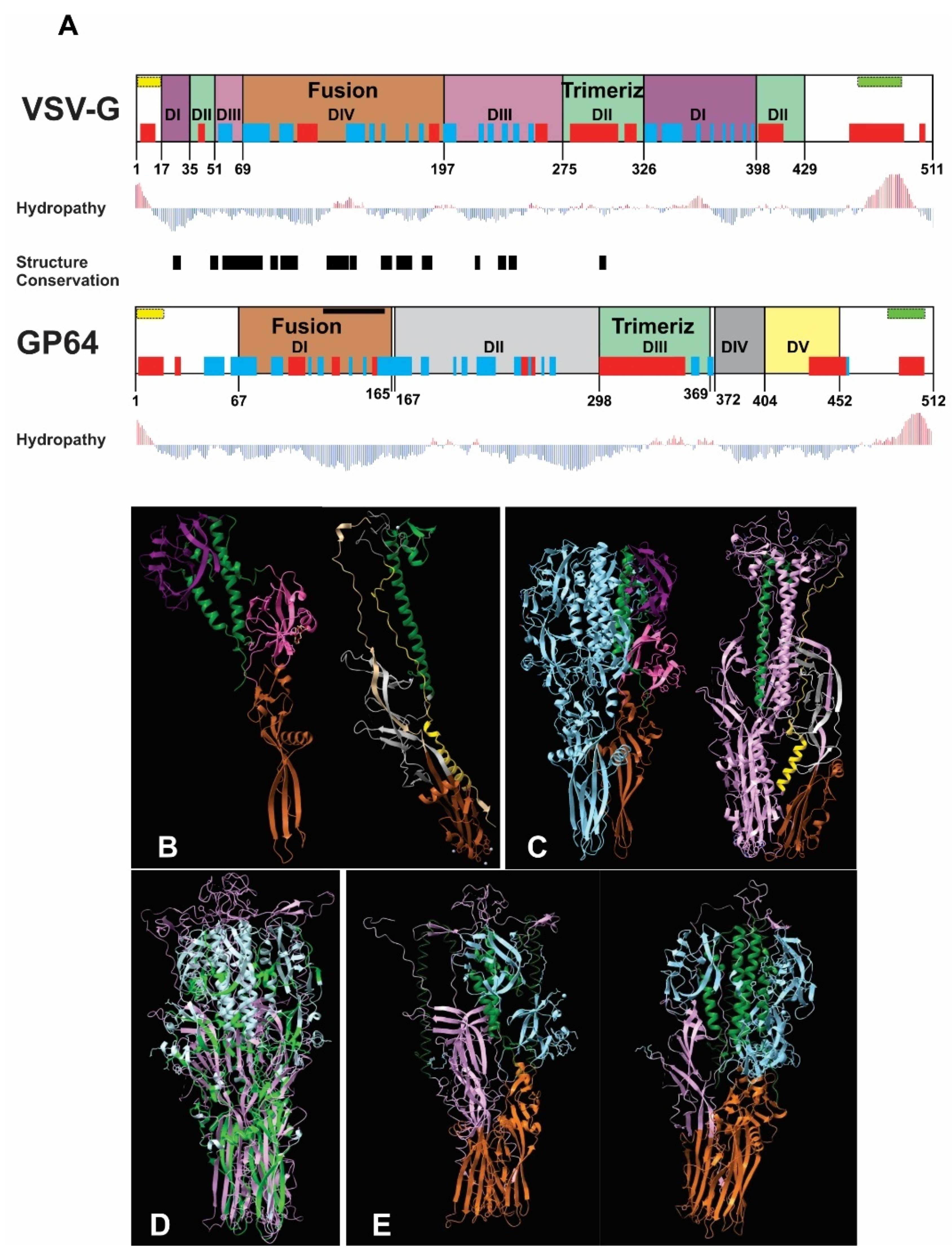
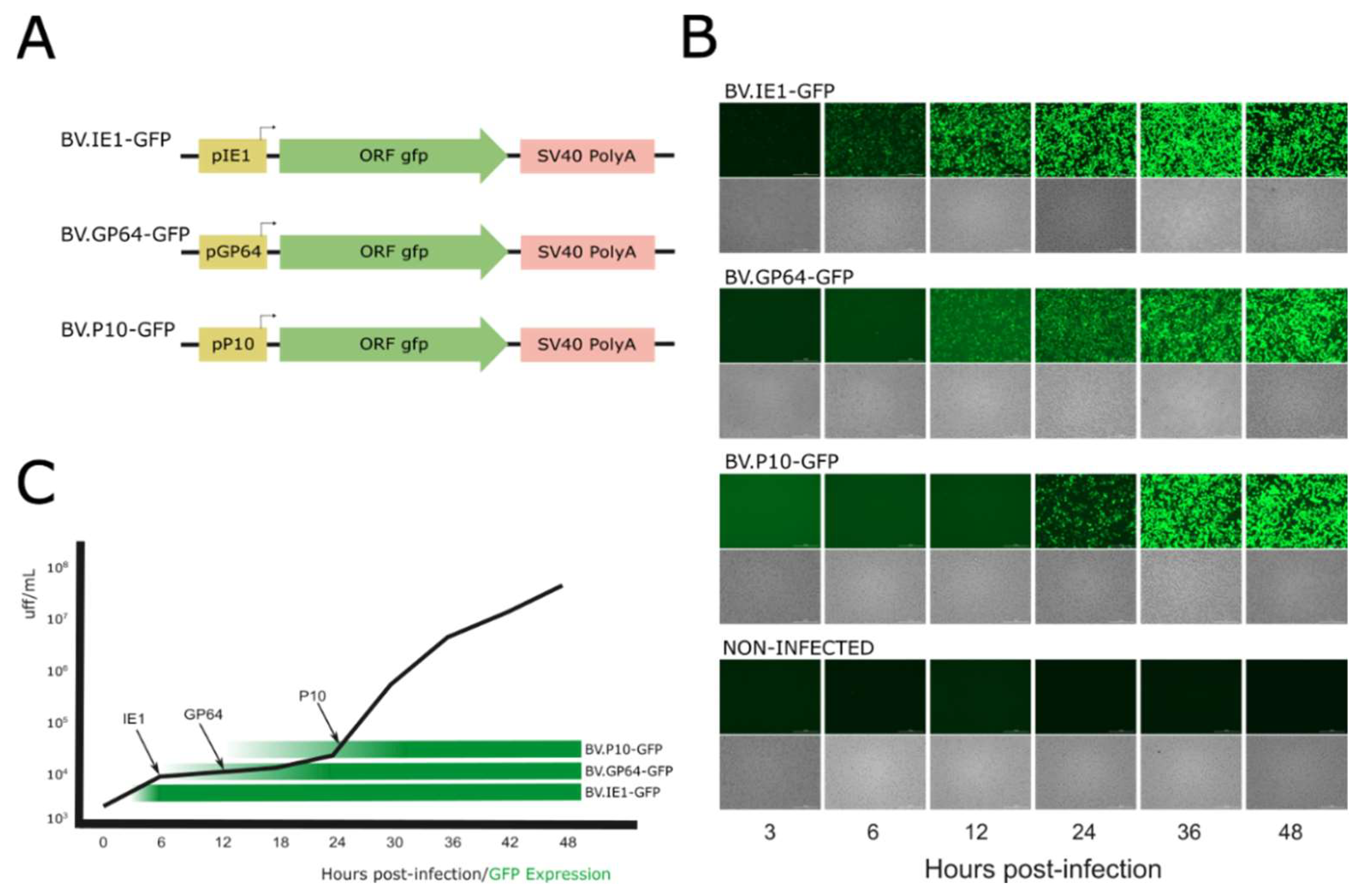
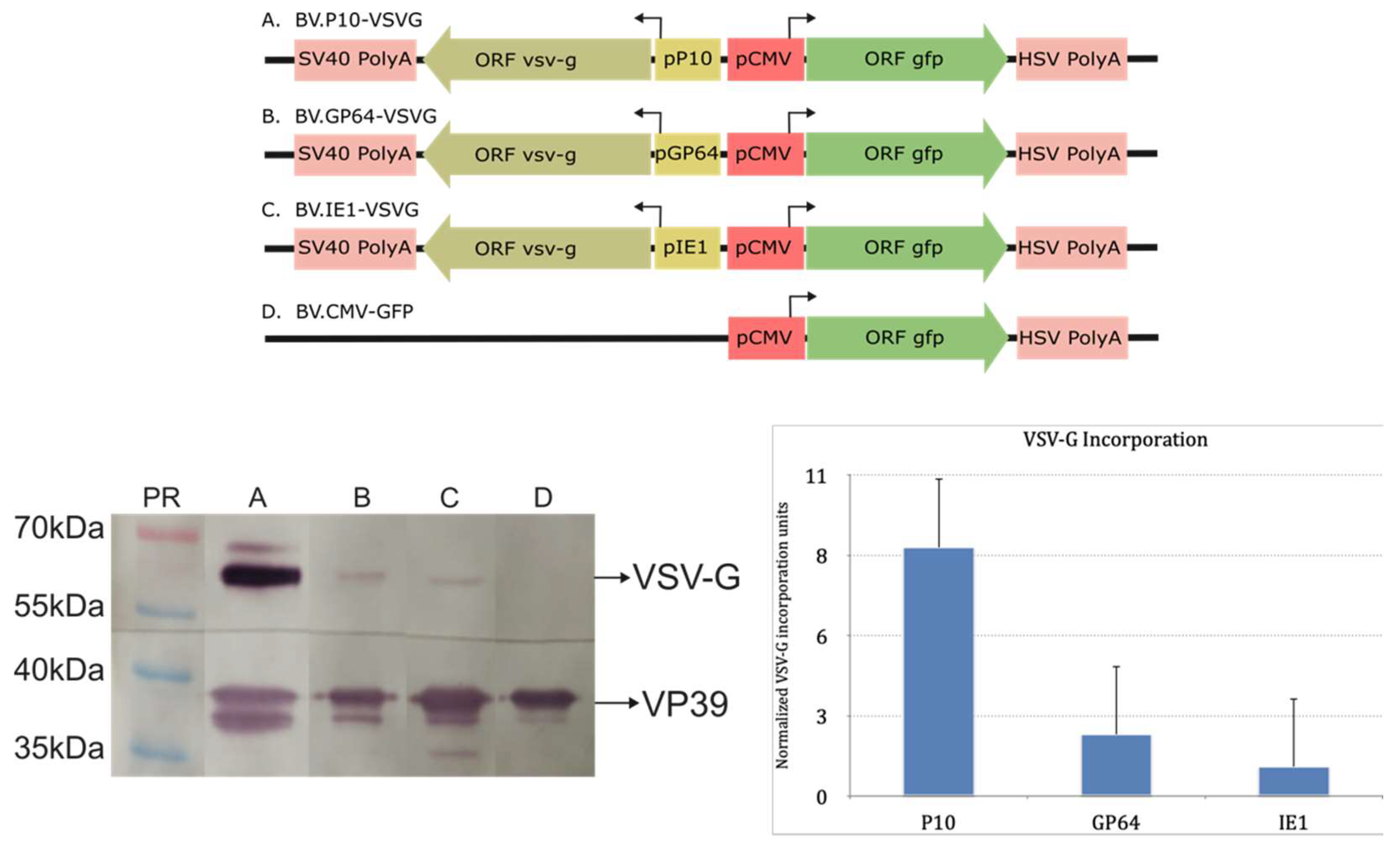
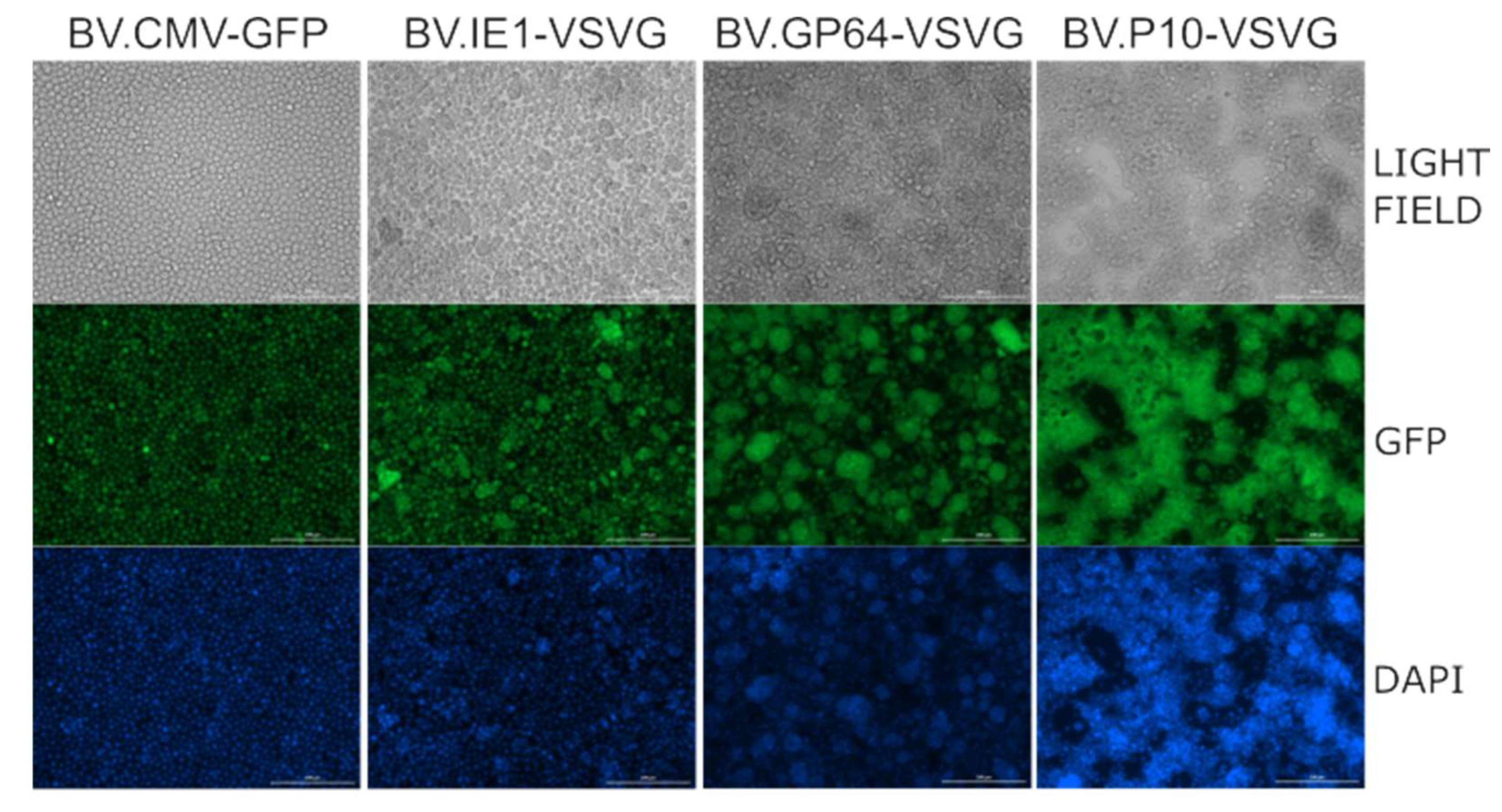

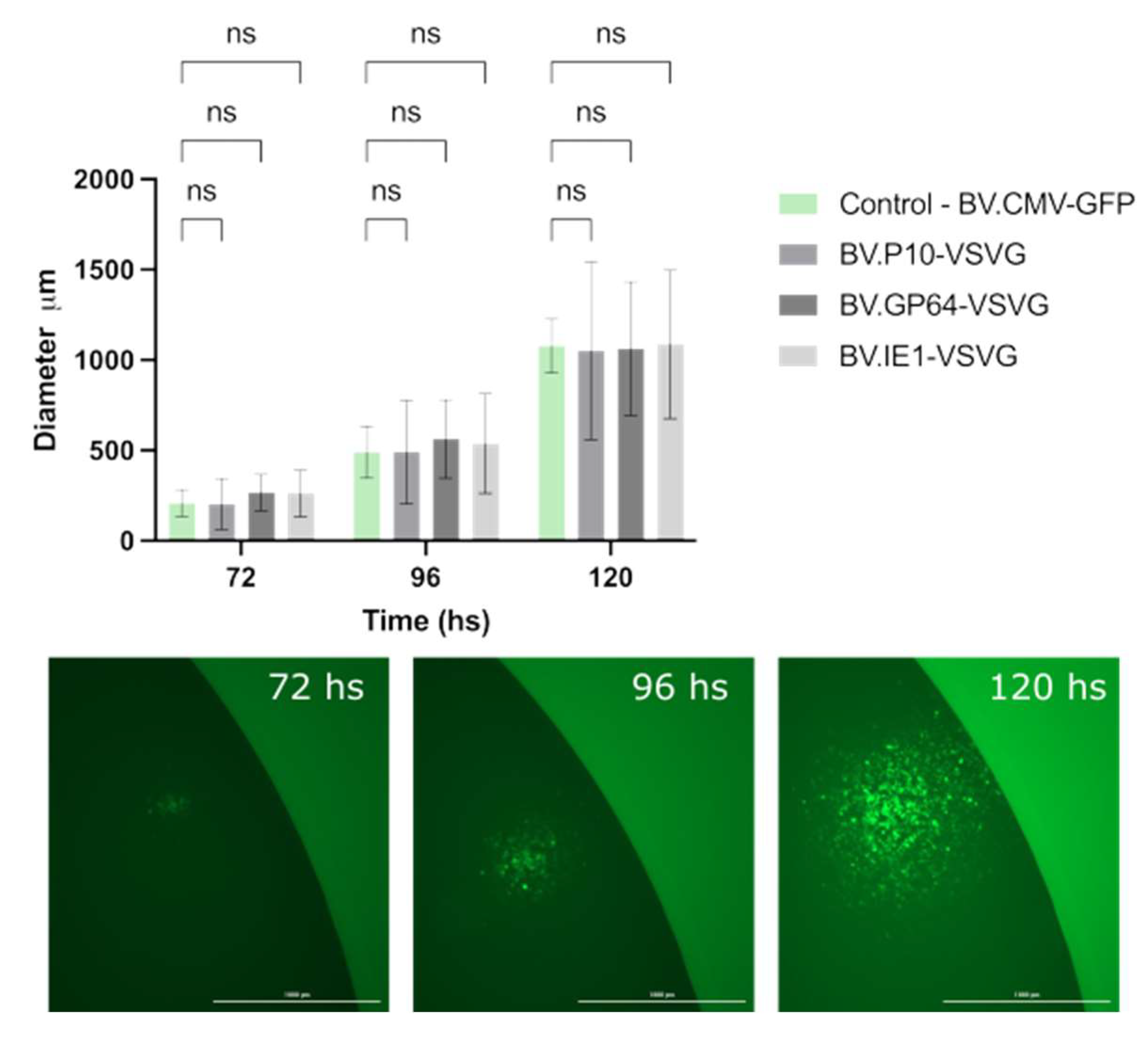
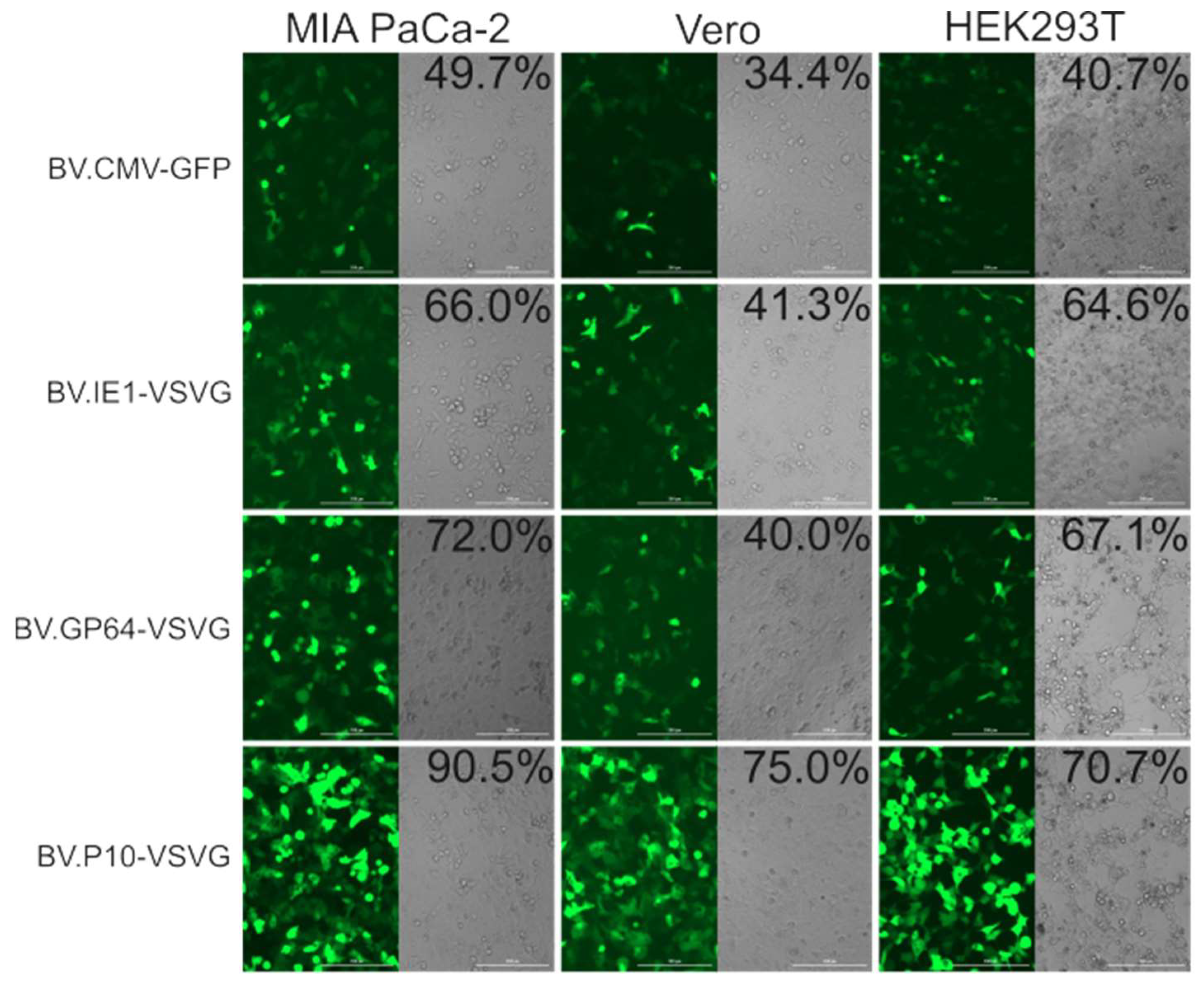
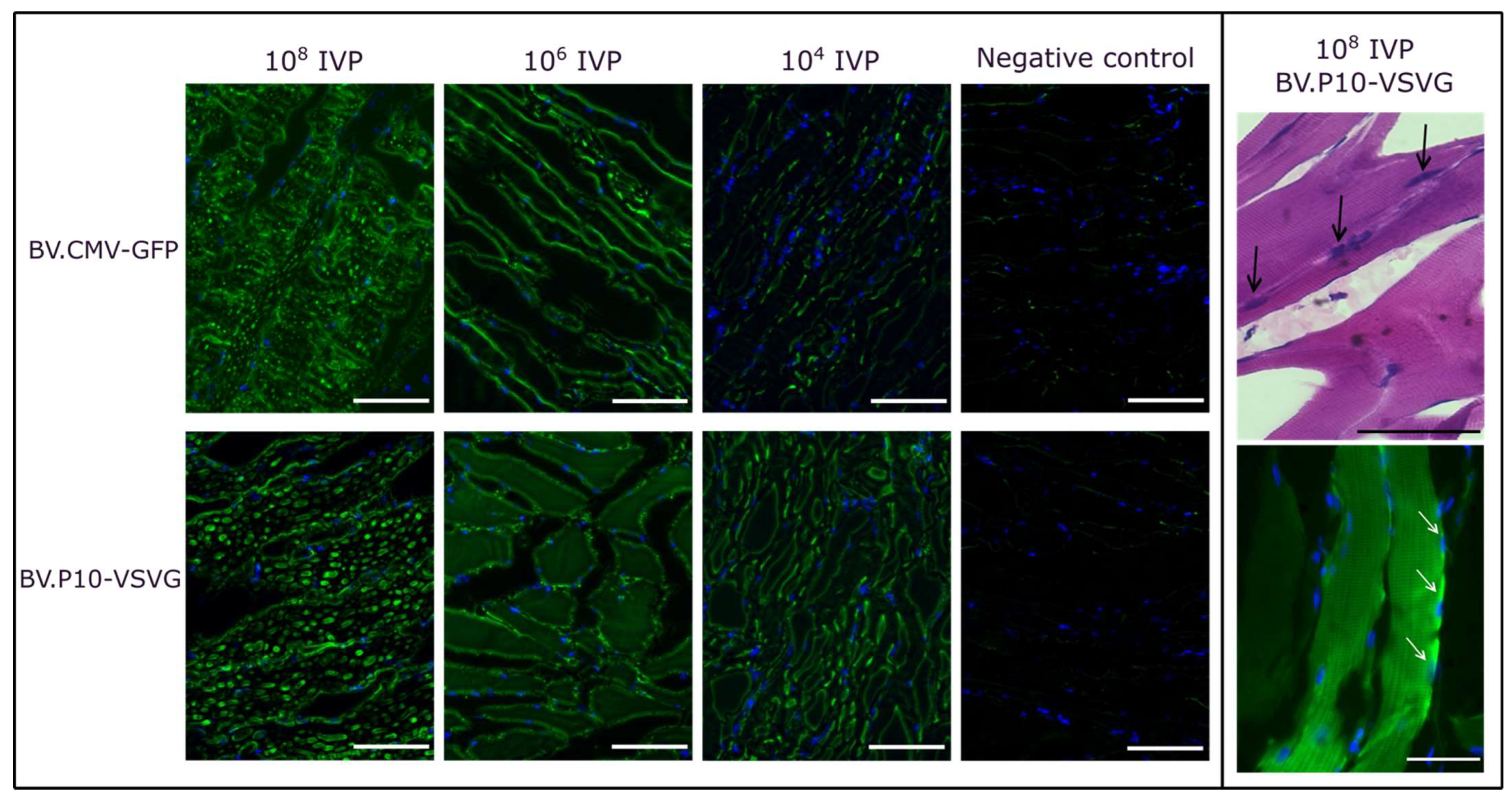
| Primer Name | Sequence (5′ to 3′) |
|---|---|
| Fw.pIE1 | CTCGAGTTGCACAACACTATTAT |
| Rv.pIE1 | GGATCCAGTCACTTGGTTGTTCAC |
| Fw.pGP64 | GGATCCCTTGCTTGTGTGTTCCTTATTG |
| Rv.pGP64 | CTCGAGGATGACCACCTCCAG |
| FwVSVG | GGATCCGACACTATGAAGTGCC |
| RvVSVG | GATATCTGATTTGAGTTACTTTCC |
| Plasmid Name | Gene Content |
| pFastBacPromIE1/GFP | pFastBac-Dual backbone, prom-ie1/gfp/spA_SV40 |
| pFastBacPromGP64/GFP | pFastBac-Dual backbone, prom-gp64/gfp/spA_SV40 |
| pFastBacPromp10/GFP | pFastBac-Dual backbone, prom-p10/gfp/spA_SV40 |
| pFastBacPromIE1/VSVG | pFastBac-Dual backbone, prom-ie1/VSV-G/spA_SV40 + prom-CMV/gfp/spA-HSV |
| pFastBacPromGP64/VSVG | pFastBac-Dual backbone, prom-gp64/VSV-G/spA_SV40 + prom-CMV/gfp/spA-HSV |
| pFastBacPromP10/VSVG | pFastBac-Dual backbone, prom-p10/VSV-G/spA-SV40 + prom-CMV/gfp/spA-HSV |
| Baculovirus Name | Gene Content |
| BV.IE1-GFP | bMON14272 backbone, prom-ie1/gfp/spA_SV40 |
| BV.GP64-GFP | bMON14272 backbone, prom-gp64/gfp/spA_SV40 |
| BV.P10-GFP | bMON14272 backbone, prom-p10/gfp/spA_SV40 |
| BV.IE1-VSVG | bMON14272 backbone, prom-ie1/VSV-G/spA_SV40 + prom-CMV/gfp/spA-HSV |
| BV.GP64-VSVG | bMON14272 backbone, prom-gp64/VSV-G/spA_SV40 + prom-CMV/gfp/spA-HSV |
| BV.P10-VSVG | bMON14272 backbone, prom-p10/VSV-G/spA_SV40 + prom-CMV/gfp/spA-HSV |
| BV.CMV-GFP | bMON14272 backbone, prom-CMV/gfp/spA-HSV |
Disclaimer/Publisher’s Note: The statements, opinions and data contained in all publications are solely those of the individual author(s) and contributor(s) and not of MDPI and/or the editor(s). MDPI and/or the editor(s) disclaim responsibility for any injury to people or property resulting from any ideas, methods, instructions or products referred to in the content. |
© 2025 by the authors. Licensee MDPI, Basel, Switzerland. This article is an open access article distributed under the terms and conditions of the Creative Commons Attribution (CC BY) license (https://creativecommons.org/licenses/by/4.0/).
Share and Cite
Simonin, J.A.; Cuccovia Warlet, F.U.; Bauzá, M.d.R.; Plastine, M.d.P.; Alfonso, V.; Olea, F.D.; Cerrudo, C.S.; Belaich, M.N. Early to Late VSV-G Expression in AcMNPV BV Enhances Transduction in Mammalian Cells but Does Not Affect Virion Yield in Insect Cells. Vaccines 2025, 13, 693. https://doi.org/10.3390/vaccines13070693
Simonin JA, Cuccovia Warlet FU, Bauzá MdR, Plastine MdP, Alfonso V, Olea FD, Cerrudo CS, Belaich MN. Early to Late VSV-G Expression in AcMNPV BV Enhances Transduction in Mammalian Cells but Does Not Affect Virion Yield in Insect Cells. Vaccines. 2025; 13(7):693. https://doi.org/10.3390/vaccines13070693
Chicago/Turabian StyleSimonin, Jorge Alejandro, Franco Uriel Cuccovia Warlet, María del Rosario Bauzá, María del Pilar Plastine, Victoria Alfonso, Fernanda Daniela Olea, Carolina Susana Cerrudo, and Mariano Nicolás Belaich. 2025. "Early to Late VSV-G Expression in AcMNPV BV Enhances Transduction in Mammalian Cells but Does Not Affect Virion Yield in Insect Cells" Vaccines 13, no. 7: 693. https://doi.org/10.3390/vaccines13070693
APA StyleSimonin, J. A., Cuccovia Warlet, F. U., Bauzá, M. d. R., Plastine, M. d. P., Alfonso, V., Olea, F. D., Cerrudo, C. S., & Belaich, M. N. (2025). Early to Late VSV-G Expression in AcMNPV BV Enhances Transduction in Mammalian Cells but Does Not Affect Virion Yield in Insect Cells. Vaccines, 13(7), 693. https://doi.org/10.3390/vaccines13070693







